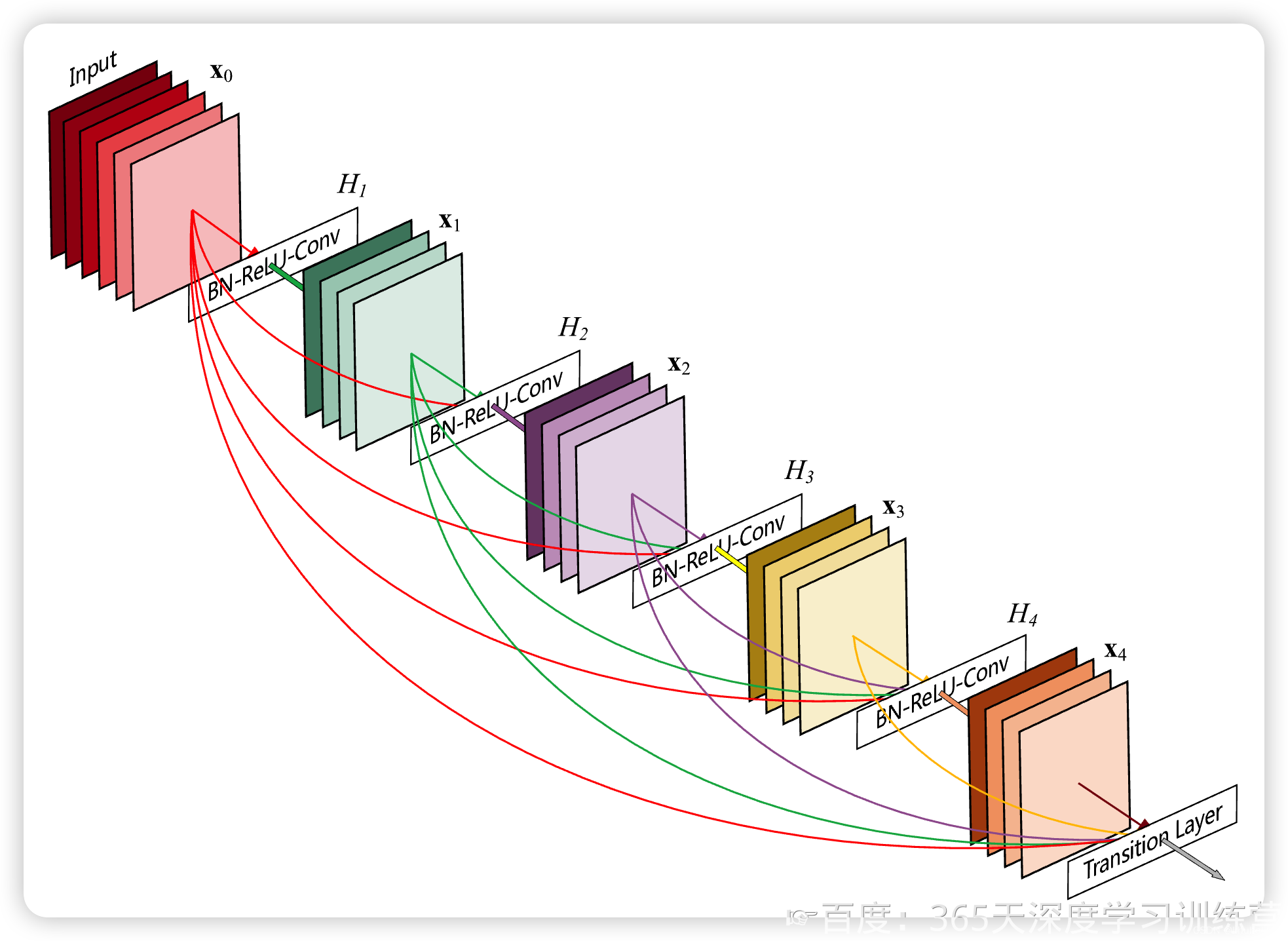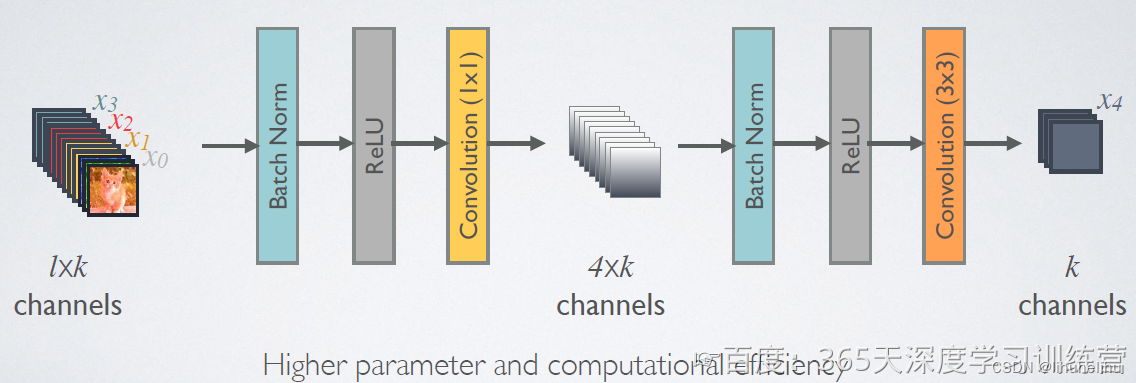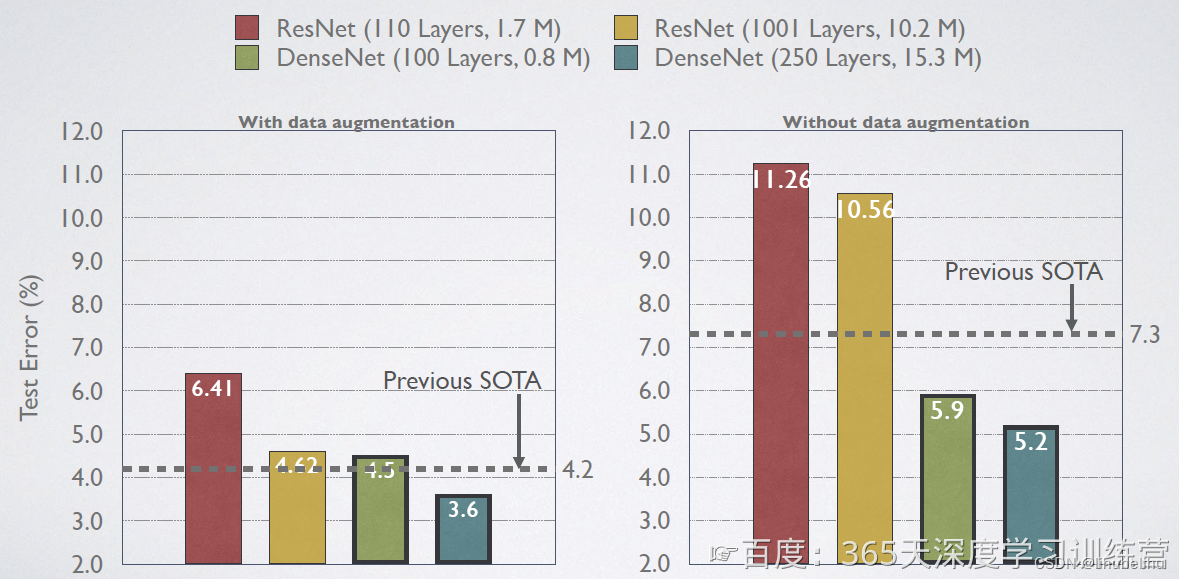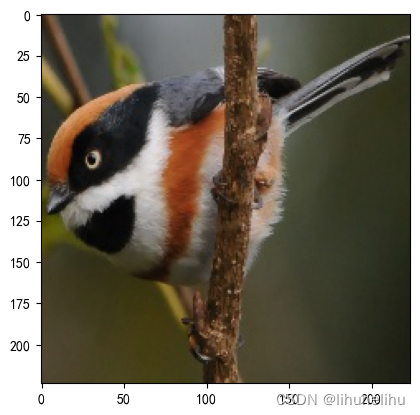>本文为[🔗365天深度学习训练营](https://mp.weixin.qq.com/s/rbOOmire8OocQ90QM78DRA) 中的学习记录博客**
> 原作者:[K同学啊 | 接辅导、项目定制](https://mtyjkh.blog.csdn.net/)**
我的环境:
系统环境:win10
语言环境:Python3.9.13
编译器:jupyter notebook
深度学习环境:Pytorch 2.3.0+cpu,torchvision 0.18.0+cpu
一、densenet模型介绍
1、前言
在计算机视觉领域,卷积神经网络(CNN)已经成为最主流的方法,比如GoogLenet,VGG-16Incepetion等模型。CNN史上的一个里程碑事件是ResNet模型的出现,ResNet可以训练出更深的CNN模型,从而实现更高的准确度。ResNet模型的核心是通过建立前面层与后面层之间的“短路连接(shortcuts,skip connection),进而训练出更深的CNN网络。
今天我们要介绍的是DenseNet模型,它的基本思路与ResNet一致,但是它建立的是前面所有层与后面层的密集连接(dense connection),它的名称也是由此而来。DenseNet的另一大特色是通过特征在channel上的连接来实现特征重用(feature reuse)。这些特点让DenseNet在参数和计算成本更少的情形下实现比ResNet更优的性能,DenseNet也因此斩获CVPR 2017的最佳论文奖。
 图1 Dense模块(5-layer,growth rate of k=4)
图1 Dense模块(5-layer,growth rate of k=4)
2、设计理念
相比ResNet,DenseNet提出了一个更激进的密集连接机制:即互相连接所有的层,具体来说就是每个层都会接受其前面所有层作为其额外的输入。
图3为ResNet网络的残差连接机制,作为对比,图4为DenseNet的密集连接机制。可以看到,ResNet是每个层与前面的某层(一般是2~4层)短路连接在一起,连接方式是通过**元素相加**。而在DenseNet中,每个层都会与前面所有层在channel维度上连接(concat)在一起(即**元素叠加**),并作为下一层的输入。
对于一个L层的网络,DenseNet共包含个连接,相比ResNet,这是一种密集连接。而且DenseNet是直接concat来自不同层的特征图,这可以实现特征重用,提升效率,这一特点是DenseNet与ResNet最主要的区别。
 图2 标准的神经网络传播过程
图2 标准的神经网络传播过程
* 输入和输出的公式是,其中
是一个组合函数,通常包括 BN、ReLU、Pooling、Conv操作,
是第
层输入的特征图,
是第
层输出的特征图。
 图3 ResNet网络的短路连接机制(其中+代表的是元素级相加操作)
图3 ResNet网络的短路连接机制(其中+代表的是元素级相加操作)
* ResNet是跨层相加,输入和输出的公式是
 图4 DenseNet 网络的密集连接机制(其中c代表的是channel级连接操作)
图4 DenseNet 网络的密集连接机制(其中c代表的是channel级连接操作)
* 而对于DesNet,则是采用跨通道concat的形式来连接,会连接前面所有层作为输入,输入和输出的公式是 。这里要注意所有的层的输入都来源于前面所有层在channel维度的concat。
3、网络结构
具体介绍网络的具体实现细节如图5所示。
 图5 DenseNet的网络结构
图5 DenseNet的网络结构
CNN网络一般要经过Pooling或者stride>1的Conv来降低特征图的大小,而DenseNet的密集连接方式需要特征图大小保持一致。为了解决这个问题,DenseNet网络中使用DenseBlock+Transition的结构,其中DenseBlock是包含很多层的模块,每个层的特征图大小相同,层与层之间采用密集连接方式。而Transition层是连接两个相邻的DenseBlock,并且通过Pooling使特征图大小降低。图6给出了DenseNet的网路结构,它共包含4个DenseBlock,各个DenseBlock之间通过Transition层连接在一起。
 图6 使用DenseBlock+Transition的DenseNet网络
图6 使用DenseBlock+Transition的DenseNet网络
在DenseBlock中,各个层的特征图大小一致,可以在channel维度上连接。DenseBlock中的非线性组合函数 H(·)的是 BN+ReLU+3x3Conv 的结构,如图7所示。另外值得注意的一点是,与ResNet不同,所有DenseBlock中各个层卷积之后均输出k个特征图,即得到的特征图的channel数为k,或者说采用个卷积核。k在DenseNet称为growthrate,这是一个超参数。一般情况下使用较小的k(比如12),就可以得到较佳的性能。假定输入层的特征图的channel数为 ,那么
层输入的channel数为
,因此随着层数增加,尽管
设定得较小,DenseBlock的输入会非常多,不过这是由于特征重用所造成的,每个层仅有
个特征是自己独有的。
 图7 DenseBlock中的非线性转换结构
图7 DenseBlock中的非线性转换结构
由于后面层的输入会非常大,DenseBlock内部可以采用bottleneck层来减少计算量,主要是原有的结构中增加1x1Conv,如图8所示,即BN+ReLU+1x1ConV+BN+ReLU+3x3Conv,称为DenseNet-B结构。其中1x1Conv得到 4个特征图,它起到的作用是降低特征数量,从而提升计算效率。
 图8 使用bottleneck层的DenseBlock结构
图8 使用bottleneck层的DenseBlock结构
对于Transition层,它主要是连接两个相邻的DenseBlock,并且降低特征图大小。Transition层包括一个1x1的卷积和2x2的AvgPooling,结构为BN+ReLU+1x1Conv+2x2AvgPooling。另外,Transition层可以起到压缩模型的作用。假定Transition层的上接DenseBlock得到的特征图channels数为,Transition层可以产生
个特征(通过卷积层),其中
是压缩系数(compressionrate)。当
时,特征个数经过Transition层没有变化,即无压缩,而当压缩系数小于1时,这种结构称为DenseNet-C,文中使用
。对于使用bottleneck层的DenseBlock结构和压缩系数小于1的Transition组合结构称为DenseNet-BC。
对于lmageNet数据集,图片输入大小为224x224,网络结构采用包含4个DenseBlock的DenseNet-BC,其首先是一个stride=2的7x7卷积层,然后是一个stride=2的3x3 MaxPooling层,后面才进入DenseBlock。lmageNet数据集所采用的网络配置如表1所示:
 表1 ImageNet数据集上所采用的DenseNet结构
表1 ImageNet数据集上所采用的DenseNet结构
4、与其他算法效果对比
 在CIFAR-100数据集上ResNet vs DenseNet
在CIFAR-100数据集上ResNet vs DenseNet
5、使用Pytorch实现DenseNet121

这里我们采用Pytorch框架来实现DenseNet,首先实现DenseBlock中的内部结构,这里是BN+ReLU+1x1Conv+BN+ReLU+3x3Conv结构,最后也加入dropout层以用于训练过程
二、用pytorch具体代码实现DenseNet121
import torch
import torch.nn as nn
import torchvision.transforms as transforms
import torchvision
from torchvision import transforms, datasets
import os,PIL,pathlib,warnings
import torch.nn.functional as F
warnings.filterwarnings("ignore") #忽略警告信息
# 设置CPU/GPU
device = torch.device("cuda" if torch.cuda.is_available() else "cpu")
train_transforms = transforms.Compose([
transforms.Resize([224,224]),
transforms.ToTensor(),
transforms.Normalize(
mean = [0.485,0.456,0.406],
std = [0.229,0.224,0.225]
)
])
test_transforms = transforms.Compose([
transforms.Resize([224,224]),
transforms.ToTensor(),
transforms.Normalize(
mean = [0.485,0.456,0.406],
std = [0.229,0.224,0.225]
)
])
# 导入数据,与J1的数据是一样的
data_dir='./J3/bird_photos/'
data_dir=pathlib.Path(data_dir)data_paths=list(data_dir.glob('*'))
classNames=[str(path).split('\\')[2] for path in data_paths]num_classes=len(classNames)
total_data = datasets.ImageFolder(data_dir,transform = train_transforms)
total_data
代码输出:
Dataset ImageFolder
Number of datapoints: 565
Root location: J3\bird_photos
StandardTransform
Transform: Compose(
Resize(size=[224, 224], interpolation=bilinear, max_size=None, antialias=True)
ToTensor()
Normalize(mean=[0.485, 0.456, 0.406], std=[0.229, 0.224, 0.225])
)
划分数据集
train_size = int(0.8 * len(total_data))
test_size = len(total_data) - train_size
train_dataset, test_dataset = torch.utils.data.random_split(total_data, [train_size, test_size])
print(train_dataset)
print(test_dataset)
batch_size = 8
train_dl = torch.utils.data.DataLoader(train_dataset,
batch_size=batch_size,
shuffle=True,
#num_workers=1
)
test_dl = torch.utils.data.DataLoader(test_dataset,
batch_size=batch_size,
shuffle=True,
#num_workers=1
)
for X, y in test_dl:
print("Shape of X [N, C, H, W]: ", X.shape)
print("Shape of y: ", y.shape, y.dtype)
break
for X, y in train_dl:
print("Shape of X [N, C, H, W]: ", X.shape)
print("Shape of y: ", y.shape, y.dtype)
break
from collections import OrderedDict
import torch
import torch.nn as nn
import torch.nn.functional as F
# BN+ReLU+1x1Conv+BN+ReLU+3x3Conv结构,最后也加入dropout层以用于训练过程
class _DenseLayer(nn.Sequential):
'''Basic unit of DenseBlock (using bottleneck layer)'''
def __init__(self,num_input_features,growth_rate,bn_size,drop_rate):
super(_DenseLayer,self).__init__()
self.add_module('norm1',nn.BatchNorm2d(num_input_features))
self.add_module('relu1',nn.ReLU(inplace=True))
self.add_module('conv1',nn.Conv2d(num_input_features, bn_size*growth_rate,kernel_size=1,stride=1,bias=False))
self.add_module('norm2',nn.BatchNorm2d(bn_size*growth_rate))
self.add_module('relu2',nn.ReLU(inplace=True))
self.add_module('conv2',nn.Conv2d(bn_size*growth_rate,growth_rate,kernel_size=3,stride=1,padding=1,bias=False))
self.drop_rate = drop_ratedef forward(self,x):
new_features =super(_DenseLayer,self).forward(x)
if self.drop_rate>0:
new_features = F.dropout(new_features,p=self.drop_rate,training=self.training)
return torch.cat([x,new_features],1)
# DenseBlock模块
# 内部是密集连接方式(输入特征数线性增长)class _DenseBlock(nn.Sequential):
def __init__(self,num_layers,num_input_features,bn_size,growth_rate,drop_rate):
super(_DenseBlock,self).__init__()
for i in range(num_layers):
layer = _DenseLayer(
num_input_features+i*growth_rate,
growth_rate,
bn_size,
drop_rate
)
self.add_module('denselayer%d'%(i+1,),layer)
# Transition模块
# 实现Transition层,主要是一个卷积层和一个池化层
'''Transition layer between two adjacent DenseBlock'''
class _Transition(nn.Sequential):
def __init__(self,num_input_feature,num_output_features):
super(_Transition,self).__init__()
self.add_module('norm',nn.BatchNorm2d(num_input_feature))
self.add_module('relu',nn.ReLU(inplace=True))
self.add_module('conv',nn.Conv2d(
num_input_feature,
num_output_features,
kernel_size=1,
stride=1,
bias=False
))
self.add_module('pool',nn.AvgPool2d(2,stride=2))
# 实现DenseNet网络
# DenseNet-BC model
class DenseNet(nn.Module):
def __init__(self,growth_rate=32,block_config=(6,12,24,16),num_init_features=64,bn_size=4,
compression_rate=0.5,drop_rate=0,num_classes=1000):
"""
:param growth_rate:(int) number of filters used in DenseLayer.'k' in the paper
:param block_config:(list of 4 ints) number of layers in eatch DenseBlock
:param num_init_features:(int) number of filters in the first Conv2d
:param bn_size:(int) the factor using in the bottleneck layer
:param compression_rate: (float) the compression rate used in Transition Layer
:param drop_rate:(float) the drop rate after each DenseLayer
:param num_classes:(int) number of classes for classification
"""
super(DenseNet,self).__init__()
# first Conv2d
self.features =nn.Sequential(OrderedDict([
('conv0',nn.Conv2d(3,num_init_features,kernel_size=7,stride=2,padding=3,bias=False)),
('norm0',nn.BatchNorm2d(num_init_features)),
('relu0',nn.ReLU(inplace=True)),
('pool0',nn.MaxPool2d(3,stride=2,padding=1))
]))
# DenseBlock
num_features =num_init_features
for i,num_layers in enumerate(block_config):
block=_DenseBlock(
num_layers,
num_features,
bn_size,
growth_rate,
drop_rate
)
self.features.add_module('denseblock%d'%(i+1),block)
num_features += num_layers*growth_rate
if i != len(block_config)-1:
transition = _Transition(
num_features,
int(num_features*compression_rate
))
self.features.add_module('transition%d'%(i+1),transition)
num_features =int(num_features*compression_rate)
# final bn+ReLU
self.features.add_module('norm5',nn.BatchNorm2d(num_features))
self.features.add_module('relu5',nn.ReLU(inplace=True))
#分类层
#classification layer
self.classifier =nn.Linear(num_features,num_classes)
#参数初始化
#params initialization
for m in self.modules():
if isinstance(m,nn.Conv2d):
nn.init.kaiming_normal_(m.weight)
elif isinstance(m,nn.BatchNorm2d):
nn.init.constant(m.bias,0)
nn.init.constant(m.weight,1)
elif isinstance(m,nn.Linear):
nn.init.constant_(m.bias,0)
def forward(self,x):
features=self.features(x)
out=F.avg_pool2d(features,7,stride=1).view(features.size(0),-1)
out=self.classifier(out)
return out
# 选择不同网络参数,就可以实现不同深度的DenseNet,这里实现DenseNet-121网络,而且Pytorch提供了预训练好的网络参数
def densenet121(pretrained=False,**kwargs):
"""DenseNet121"""
model = DenseNet(num_init_features=64,growth_rate=32,block_config=(6,12,24,16),**kwargs)
if pretrained:
#'.'s are no longer allowed in module names, but pervious DenseLayer
# has keys 'norm.1','relu.1','conv.1','norm.2','relu.2','conv.2'
# They are also in the checkpoints in model_urls. This pattern is used
# to find such keys.
pattern =re.compile(
r'^(.*denselayer\d+\.(?:norm|relu|conv))\.((?:[12])\.(?:weight|bias|running_mean|running_var))$')
state_dict = model_zoo.load_url(model_urls['densenet121'])
for key in list(state_dict.keys()):
res = pattern.match(key)
if res:
new_key= res.group(1)+ res.group(2)
state_dict[new_key]= state_dict[key]
del state_dict[key]
model.load_state_dict(state_dict)
return modelmodel=densenet121().to(device)
# 统计模型参数量以及其他指标
import torchsummary as summary
summary.summary(model,(3,224,224))
# 编写训练函数
def train(dataloader,model,loss_fn,optimizer):
size = len(dataloader.dataset)
num_batches = len(dataloader)
train_acc,train_loss = 0,0
for X,y in dataloader:
X,y = X.to(device),y.to(device)
pred = model(X)
loss = loss_fn(pred,y)
optimizer.zero_grad()
loss.backward()
optimizer.step()
train_loss += loss.item()
train_acc += (pred.argmax(1) == y).type(torch.float).sum().item()
train_loss /= num_batches
train_acc /= size
return train_acc,train_loss
# 编写测试函数
def test(dataloader, model, loss_fn):
size = len(dataloader.dataset) # 测试集的大小
num_batches = len(dataloader) # 批次数目, (size/batch_size,向上取整)
test_loss, test_acc = 0, 0
# 当不进行训练时,停止梯度更新,节省计算内存消耗
with torch.no_grad():
for imgs, target in dataloader:
imgs, target = imgs.to(device), target.to(device)
# 计算loss
target_pred = model(imgs)
loss = loss_fn(target_pred, target)
test_loss += loss.item()
test_acc += (target_pred.argmax(1) == target).type(torch.float).sum().item()
test_acc /= size
test_loss /= num_batches
return test_acc, test_loss
import copy
loss_fn = nn.CrossEntropyLoss()
learn_rate = 1e-4
# SGD与Adam优化器,选择其中一个
# opt = torch.optim.SGD(model.parameters(),lr=learn_rate)
opt = torch.optim.Adam(model.parameters(),lr=learn_rate)scheduler=torch.optim.lr_scheduler.StepLR(opt,step_size=1,gamma=0.9) #定义学习率高度器
epochs = 100 #设置训练模型的最大轮数为100,但可能到不了100
patience=10 #早停的耐心值,即如果模型连续10个周期没有准确率提升,则跳出训练
train_loss=[]
train_acc=[]
test_loss=[]
test_acc=[]
best_acc = 0 #设置一个最佳的准确率,作为最佳模型的判别指标
no_improve_epoch=0 #用于跟踪准确率是否提升的计数器
epoch=0 #用于统计最终的训练模型的轮数,这里设置初始值为0;为绘图作准备,这里的绘图范围不是epochs = 100
#开始训练
for epoch in range(epochs):
model.train()
epoch_train_acc,epoch_train_loss = train(train_dl,model,loss_fn,opt)
model.eval()
epoch_test_acc,epoch_test_loss = test(test_dl,model,loss_fn)
if epoch_test_acc > best_acc:
best_acc = epoch_test_acc
best_model = copy.deepcopy(model)
no_improve_epoch=0 #重置计数器
#保存最佳模型的检查点
PATH='./J3_best_model(121).pth'
torch.save({
'epoch':epoch,
'model_state_dict':best_model.state_dict(),
'optimizer_state_dict':opt.state_dict(),
'loss':epoch_test_loss,
},PATH)
else:
no_improve_epoch += 1
if no_improve_epoch >= patience:
print(f"Early stoping triggered at epoch {epoch+1}")
break #早停
train_acc.append(epoch_train_acc)
train_loss.append(epoch_train_loss)
test_acc.append(epoch_test_acc)
test_loss.append(epoch_test_loss)
scheduler.step() #更新学习率
lr = opt.state_dict()['param_groups'][0]['lr']
template = ('Epoch:{:2d}, Train_acc:{:.1f}%, Train_loss:{:.3f}, Test_acc:{:.1f}%, Test_loss:{:.3f}, Lr:{:.2E}')
print(template.format(epoch+1, epoch_train_acc*100, epoch_train_loss,epoch_test_acc*100, epoch_test_loss, lr))
# 保存最佳模型到文件中
PATH='./j3_best_model_121.pth' #保存的参数文件名
torch.save(model.state_dict(),PATH)
print('Done')
print(epoch)
print('no_improve_epoch:',no_improve_epoch)
代码输出:
Epoch: 1, Train_acc:54.0%, Train_loss:4.302, Test_acc:66.4%, Test_loss:1.682, Lr:9.00E-05 Epoch: 2, Train_acc:75.7%, Train_loss:1.219, Test_acc:77.9%, Test_loss:0.824, Lr:8.10E-05 Epoch: 3, Train_acc:80.5%, Train_loss:0.662, Test_acc:77.0%, Test_loss:0.747, Lr:7.29E-05 Epoch: 4, Train_acc:85.4%, Train_loss:0.475, Test_acc:82.3%, Test_loss:0.610, Lr:6.56E-05 Epoch: 5, Train_acc:89.6%, Train_loss:0.375, Test_acc:81.4%, Test_loss:0.546, Lr:5.90E-05 Epoch: 6, Train_acc:89.8%, Train_loss:0.343, Test_acc:87.6%, Test_loss:0.456, Lr:5.31E-05 Epoch: 7, Train_acc:91.6%, Train_loss:0.318, Test_acc:88.5%, Test_loss:0.395, Lr:4.78E-05 Epoch: 8, Train_acc:93.1%, Train_loss:0.241, Test_acc:85.8%, Test_loss:0.373, Lr:4.30E-05 Epoch: 9, Train_acc:92.7%, Train_loss:0.254, Test_acc:89.4%, Test_loss:0.403, Lr:3.87E-05 Epoch:10, Train_acc:94.0%, Train_loss:0.203, Test_acc:87.6%, Test_loss:0.305, Lr:3.49E-05 Epoch:11, Train_acc:95.6%, Train_loss:0.152, Test_acc:87.6%, Test_loss:0.319, Lr:3.14E-05 Epoch:12, Train_acc:97.8%, Train_loss:0.133, Test_acc:90.3%, Test_loss:0.529, Lr:2.82E-05 Epoch:13, Train_acc:94.2%, Train_loss:0.177, Test_acc:87.6%, Test_loss:0.425, Lr:2.54E-05 Epoch:14, Train_acc:97.8%, Train_loss:0.143, Test_acc:86.7%, Test_loss:0.339, Lr:2.29E-05 Epoch:15, Train_acc:97.1%, Train_loss:0.135, Test_acc:90.3%, Test_loss:0.354, Lr:2.06E-05 Epoch:16, Train_acc:98.5%, Train_loss:0.099, Test_acc:92.0%, Test_loss:0.335, Lr:1.85E-05 Epoch:17, Train_acc:97.3%, Train_loss:0.116, Test_acc:92.9%, Test_loss:0.262, Lr:1.67E-05 Epoch:18, Train_acc:98.9%, Train_loss:0.084, Test_acc:91.2%, Test_loss:0.290, Lr:1.50E-05 Epoch:19, Train_acc:98.2%, Train_loss:0.100, Test_acc:91.2%, Test_loss:0.317, Lr:1.35E-05 Epoch:20, Train_acc:97.8%, Train_loss:0.132, Test_acc:91.2%, Test_loss:0.310, Lr:1.22E-05 Epoch:21, Train_acc:97.6%, Train_loss:0.114, Test_acc:90.3%, Test_loss:0.339, Lr:1.09E-05 Epoch:22, Train_acc:98.7%, Train_loss:0.095, Test_acc:91.2%, Test_loss:0.287, Lr:9.85E-06 Epoch:23, Train_acc:98.0%, Train_loss:0.087, Test_acc:90.3%, Test_loss:0.277, Lr:8.86E-06 Epoch:24, Train_acc:98.0%, Train_loss:0.114, Test_acc:92.0%, Test_loss:0.285, Lr:7.98E-06 Epoch:25, Train_acc:97.3%, Train_loss:0.113, Test_acc:92.0%, Test_loss:0.291, Lr:7.18E-06 Epoch:26, Train_acc:99.3%, Train_loss:0.058, Test_acc:92.0%, Test_loss:0.317, Lr:6.46E-06 Early stoping triggered at epoch 27 Done 26 no_improve_epoch: 10
# 结果可视化
# Loss与Accuracy图import matplotlib.pyplot as plt
#隐藏警告
import warnings
warnings.filterwarnings("ignore") #忽略警告信息
plt.rcParams['font.sans-serif'] = ['SimHei'] # 用来正常显示中文标签
plt.rcParams['axes.unicode_minus'] = False # 用来正常显示负号
plt.rcParams['figure.dpi'] = 100 #分辨率
epochs_range = range(epoch)
plt.figure(figsize=(12, 3))
plt.subplot(1, 2, 1)
plt.plot(epochs_range, train_acc, label='Training Accuracy')
plt.plot(epochs_range, test_acc, label='Test Accuracy')
plt.legend(loc='lower right')
plt.title('Training and Validation Accuracy')
plt.subplot(1, 2, 2)
plt.plot(epochs_range, train_loss, label='Training Loss')
plt.plot(epochs_range, test_loss, label='Test Loss')
plt.legend(loc='upper right')
plt.title('Training and Validation Loss')
plt.show()
代码输出:

预测:
from PIL import Image
classes = list(total_data.class_to_idx)
def predict_one_image(image_path, model, transform, classes):
test_img = Image.open(image_path).convert('RGB')
plt.imshow(test_img) # 展示预测的图片test_img = transform(test_img)
img = test_img.to(device).unsqueeze(0)
model.eval()
output = model(img)_,pred = torch.max(output,1)
pred_class = classes[pred]
print(f'预测结果是:{pred_class}')
import os
from pathlib import Path
import random
image=[]
def image_path(data_dir):
file_list=os.listdir(data_dir) #列出四个分类标签
data_file_dir=file_list #从四个分类标签中随机选择一个
data_dir=Path(data_dir)
for i in data_file_dir:
i=Path(i)
image_file_path=data_dir.joinpath(i) #拼接路径
data_file_paths=image_file_path.iterdir() #罗列文件夹的内容
data_file_paths=list(data_file_paths) #要转换为列表
image.append(data_file_paths)
file=random.choice(image) #从所有的图像中随机选择一类
file=random.choice(file) #从选择的类中随机选择一张图片
return filedata_dir='J3/bird_photos'
image_path=image_path(data_dir)# 预测训练集中的某张照片
predict_one_image(image_path=image_path,
model=model,
transform=train_transforms,
classes=classes)
代码输出:
预测结果是:Black Throated Bushtiti
# 模型评估
# 将参数加载到model当中
best_model.load_state_dict(torch.load(PATH,map_location=device))
epoch_test_acc,epoch_test_loss=test(test_dl,best_model,loss_fn)
epoch_test_acc,epoch_test_loss
代码输出:
(0.9203539823008849, 0.28216510570297637)
三、总结
根据表1,可以实现DenseNet-169、DenseNet-201、DenseNet-264。在DenseNet-121的基础上,也就是在上面的代码中找到参数block_config=(6,12,24,16),作出如下的修改:
DenseNet-169:block_config=(6,12,32,32)
DenseNet-201:block_config=(6,12,48,32)
DenseNet-264:block_config=(6,12,64,48)
四、DenseNet-121网络结构图

























 被折叠的 条评论
为什么被折叠?
被折叠的 条评论
为什么被折叠?








